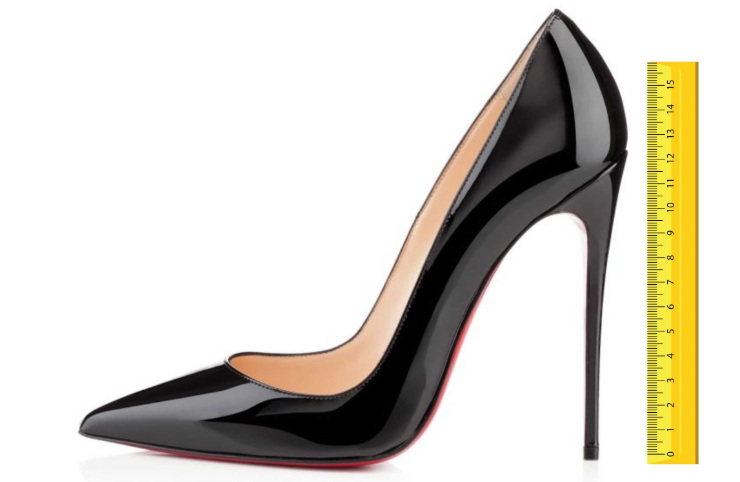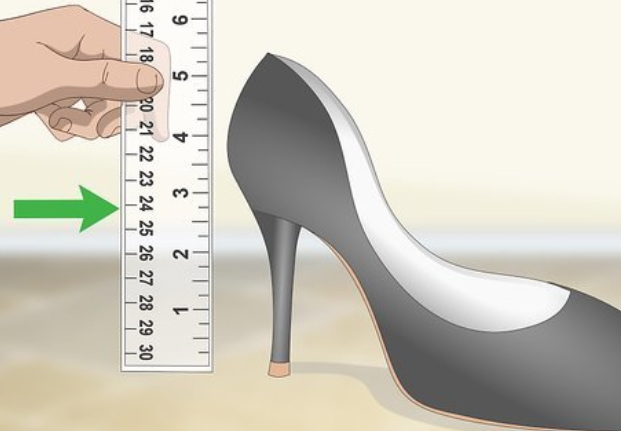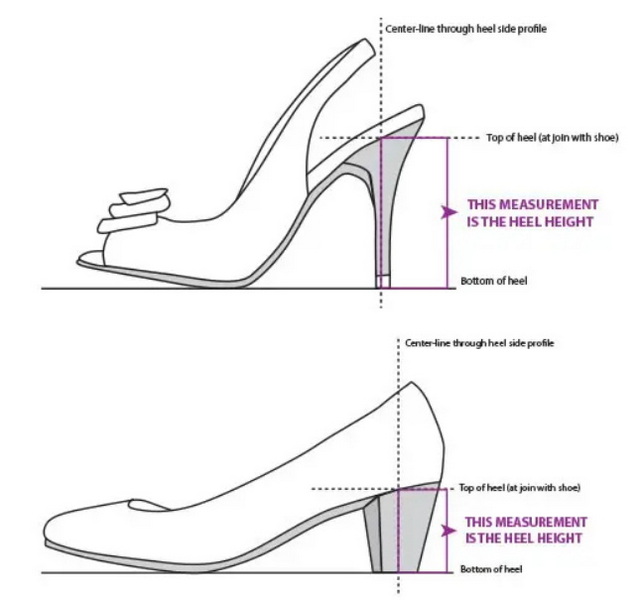Content Menu
● The Importance of Accurate Heel Measurement
● Step-by-Step Guide to Measuring Heel Height
>> 1. Gather Your Materials
>> 2. Prepare the Shoe
>> 3. Locate the Measurement Points
>> 4. Measure the Heel
>> 5. Record the Measurement
● Special Considerations for Different Heel Types
>> Measuring Platform Heels
>> Measuring Wedge Heels
● Video Tutorial: How to Measure Heel Height
● The Impact of Shoe Size on Heel Height
● Finding Your Ideal Heel Height
● Health Considerations
● Tips for Comfortable Heel Wearing
● Conclusion
● Frequently Asked Questions
>> 1. How does heel height affect posture and walking?
>> 2. Can wearing high heels regularly change foot shape?
>> 3. What's the difference between heel height and effective heel height?
>> 4. How often should I replace my high heels?
>> 5. Are there any exercises I can do to make wearing heels more comfortable?
● Citations:
Measuring the height of women's heels is an essential skill for both shoe enthusiasts and casual wearers alike. Whether you're shopping for the perfect pair of stilettos or trying to determine if a particular heel height is comfortable for you, understanding how to measure heel height accurately is crucial. In this comprehensive guide, we'll explore the various methods and considerations involved in measuring women's heel height, along with tips for finding the ideal heel for your needs.

The Importance of Accurate Heel Measurement
Knowing the exact height of a heel is more than just a matter of fashion. It can significantly impact your comfort, posture, and even your health. Wearing heels that are too high for extended periods can lead to foot pain, back problems, and other health issues. On the other hand, choosing the right heel height can enhance your appearance, boost your confidence, and provide the perfect balance between style and comfort.
Step-by-Step Guide to Measuring Heel Height
1. Gather Your Materials
To measure heel height accurately, you'll need:
- The shoe you want to measure
- A flat, level surface
- A ruler or measuring tape
- A pen and paper to record measurements
2. Prepare the Shoe
Place the shoe on a flat surface, ensuring it's stable and upright. The shoe should be in the position it would naturally be in when worn.
3. Locate the Measurement Points
Identify the two key points for measurement:
- The base of the heel where it meets the ground
- The point where the heel connects to the sole of the shoe
4. Measure the Heel
Using your ruler or measuring tape, measure from the base of the heel to where it meets the sole of the shoe. This measurement should be taken along the back center of the heel for the most accurate result[1][2].
5. Record the Measurement
Note down the measurement in either inches or centimeters, depending on your preference or the standard used in your region.

Special Considerations for Different Heel Types
Measuring Platform Heels
For platform shoes, you'll need to consider both the heel height and the platform height:
1. Measure the heel height as described above.
2. Measure the platform height at the front of the shoe.
3. Subtract the platform height from the heel height to get the effective heel height[6].
Measuring Wedge Heels
Wedges require a slightly different approach:
1. Measure from the back of the wedge where it touches the ground to where it connects with the sole at the heel.
2. Optionally, measure the height at the forefoot to understand the slope[3].
Video Tutorial: How to Measure Heel Height
For a visual guide on measuring heel height, check out this helpful video:
The Impact of Shoe Size on Heel Height
Interestingly, heel height can vary slightly depending on shoe size. Larger shoe sizes may have slightly taller heels to maintain proportionality. For example, a size 7 shoe with a 4-inch heel might have a slightly taller heel in a size 12 to keep the overall look balanced[5].
Finding Your Ideal Heel Height
The perfect heel height varies from person to person and depends on factors such as foot shape, arch height, and personal comfort. Here's a general guide:
- Low heels (1-2 inches): Ideal for beginners or those prioritizing comfort
- Mid heels (2-3 inches): A good balance of style and comfort
- High heels (3-4 inches): For experienced heel wearers or special occasions
- Very high heels (4+ inches): Best reserved for short durations and those accustomed to high heels
Health Considerations
While heels can be stylish and empowering, it's important to consider their impact on your health:
- Doctors generally advise against wearing heels higher than 4 centimeters (about 1.5 inches) on a daily basis[6].
- The larger your foot size, the higher the heel you can safely wear, but moderation is key.
- Alternating between heels and flats can help give your feet a rest and prevent long-term issues[9].
Tips for Comfortable Heel Wearing
1. Start with lower heels and gradually increase height as you become more comfortable.
2. Ensure proper fit – your heel should not slip out, and your toes should not be cramped.
3. Use insoles or padding for additional comfort.
4. Practice walking in heels at home before wearing them out.
5. Take breaks and stretch your feet when wearing high heels for extended periods.
Conclusion
Measuring women's heel height is a straightforward process that can greatly impact your shoe-wearing experience. By following the steps outlined in this guide, you can accurately determine the height of any heel and make informed decisions about your footwear choices. Remember that while style is important, comfort and health should always be prioritized. Whether you're a heel enthusiast or an occasional wearer, understanding heel height measurement will help you find the perfect balance between fashion and function.

Frequently Asked Questions
1. How does heel height affect posture and walking?
Higher heels can alter your posture by shifting your center of gravity forward, which can lead to an exaggerated arch in your lower back. This change in posture can affect your walking gait, potentially causing strain on your back, hips, and knees over time. It's important to maintain good posture and consider lower heels for everyday wear to minimize these effects.
2. Can wearing high heels regularly change foot shape?
Yes, regular wear of high heels can potentially change the shape of your feet over time. Prolonged use can shorten the Achilles tendon, alter the natural alignment of your toes, and even lead to conditions like bunions or hammer toes. It's advisable to alternate between different heel heights and shoe types to minimize these risks.
3. What's the difference between heel height and effective heel height?
Heel height is the total measurement from the bottom of the heel to where it meets the shoe's sole. Effective heel height, often used for platform shoes, is the difference between the heel height and the platform height at the front of the shoe. This measurement gives a more accurate representation of how high your heel feels when wearing the shoe.
4. How often should I replace my high heels?
The lifespan of high heels depends on factors like frequency of wear, quality of materials, and how well they're maintained. As a general rule, if you wear your heels regularly (2-3 times a week), consider replacing them every 6-12 months. Signs that it's time for a new pair include worn-down heels, cracks in the sole, or any structural damage to the shoe.
5. Are there any exercises I can do to make wearing heels more comfortable?
Yes, there are several exercises that can help strengthen your feet and improve your comfort in heels:
- Toe raises: Stand flat-footed and raise your toes off the ground, hold for a few seconds, then lower.
- Ankle rotations: Sit and rotate your ankles in circles, both clockwise and counterclockwise.
- Calf stretches: Stand facing a wall, place one foot behind you, and lean forward to stretch the calf muscle.
- Ball rolls: Roll a tennis ball or golf ball under your foot to massage and stretch the muscles.
Performing these exercises regularly can help increase foot strength and flexibility, making heel-wearing more comfortable.
Citations:
[1] https://www.pavers.co.uk/blogs/fitting-guide-how-to-measure-heel-height
[2] https://help.kurtgeiger.com/hc/en-gb/articles/360018872940-How-Do-I-Measure-Heel-And-Boot-Height
[3] https://shoefairyofficial.com/blogs/news/how-to-measure-your-ideal-heel-height
[4] https://www.youtube.com/watch?v=wkSDAvC2ecg
[5] https://www.youtube.com/watch?v=WQosiW0ZMA8
[6] https://footwearmagazine.com/the-art-of-measuring-high-heel-height/
[7] https://www.supadance.com/blog/how-to-measure-heel-height
[8] https://www.zappos.com/measurement-guide
[9] https://www.clarks.com/en-gb/editorial/best-heel-height-and-how-to-measure-heel-height

















